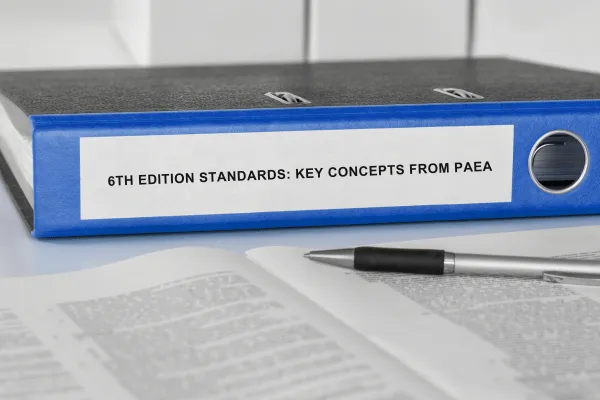
6th Edition Assessment Standards Vol 2
6th Edition Standards: Key Concepts from PAEA
Greetings, my fellow PA Education Professionals. In last week’s blog, we began examining ARC-PA’s recently released 6th Edition Standards. I’m using the current blog series to highlight the key points from my recent webinar, where I shared my initial review of the changes. I aim to enhance understanding of the new changes for programs facing a comprehensive review in 2026 and 2027.
To that end, let’s review some takeaway points provided during October’s PAEA conference. My colleague Katherine A. Demedis, a Principal at Powers Pyles Sutter & Verville, PC, presented these key concepts regarding the revised Standards. With her permission, I’d like to share these with you. They provide a fairly succinct view of what differences we’ll see when completing our SSRs. Katherine’s points are bold and italicized.
The “Self-Study Report” is now part of the main body of the Application under Standard C1.01 and Standard C1.02. As you will see, the SSR has been significantly restructured to be more streamlined and directed.
The ARC-PA has also provided spreadsheets for programs to complete, to display their data. Specific data is required, while other data is optional. The templates include specific survey items for programs to include in their surveys for students, faculty, and staff.
This is the list of sources defined as essential for analysis. When filling out your SSR templates as designed by ARa-PA, specific information is required from these resources.
program-defined admissions data
PANCE scores and sub-scores
didactic attrition, clinical attrition, and overall attrition
course grades, didactic and clinical (including exam scores as appropriate)
course and instructor evaluations, including clinical sites and preceptors
summative evaluation results
graduate/exiting student evaluation of the program
program-defined measures of effectiveness of the program director, principal faculty, and medical director in their roles outside of teaching
remediation
In addition to data tables for the items listed in the standard, required comparisons to be displayed on the table provided in the application (program may do more if it chooses) include:
Admission data compared to didactic attrition, course grades, and PANCE scores
Didactic and Clinical course grades compared to instructor and course evaluations and related PANCE sub-scores (if applicable)
Attrition compared to course grades and remediation
Course grades compared to summative exam results, remediation, and PANCE score
Summative evaluation results compared to exit survey results and program competencies
SCPE preceptors for each discipline are compared to each other (e.g., surgery preceptors are all compared to each other)
You will note that all of these required comparisons describe cross-walking data between each other, in terms of relationships.
There are five analysis questions required for Standard C1.01 (regarding the effectiveness of program faculty, the admissions process, the didactic curriculum, the clinical curriculum, and preparing graduates for clinical practice) and two for Standard C1.02 (regarding sufficient faculty and sufficient staff).
For each analysis question, the program must choose at least three data sets to use for data analysis, some of which are specified by the ARC-PA.
In the data sets you use for triangulation, some are specified (resources from the list provided above), but you may also choose others of your own.
As a point of caution, while there is now a more comprehensive “runway” provided by ARC-PA’s templates that demonstrates better what data they want to see, I advise continuing with the usual analysis that your program has done before.
I also want to remind you that more specific guidance for ARC-PA doesn’t relax the paramount importance of your program’s data collection. Self-assessment has not really changed. Programs must continue to collect longitudinal data and conduct frequent data analysis within a highly effective committee structure. There will be expectations for committee minutes to align with the analysis in the same manner as the 5th Edition standards. Don't assume that these requirements have been diminished. Having a compliance assessment process will be paramount to achieving compliance, as it has been in the past.
Standard C1.03 was recently removed from the 6th Edition Standards. The ARC-PA explained that it still wants to ensure the institution is providing sufficient resources to the program, but that this will be addressed in the A Standard section of the application, rather than in the self-study report.
Standard C1.03 may have been rescinded, but it does not state that gathering data is no longer required. The data analysis can be used to support your narratives in the A Standards. I suggest that you gather, collect, and analyze all the data in the rescinded standard, synthesizing evidence within your application in the A Standards.
Next time…
There’s more to come! In next week’s blog, we’ll continue to explore Katherine’s key concepts regarding the updated Standards. Please join me then. We’re all navigating this new territory together, and I look forward to clarifying what I can to help your program continue ongoing self-assessment in the way best suited to the requirements of ARC-PA.


